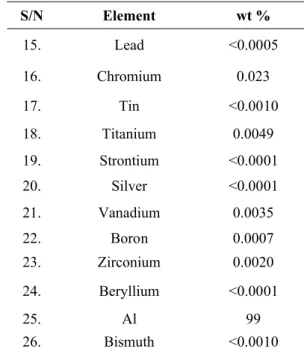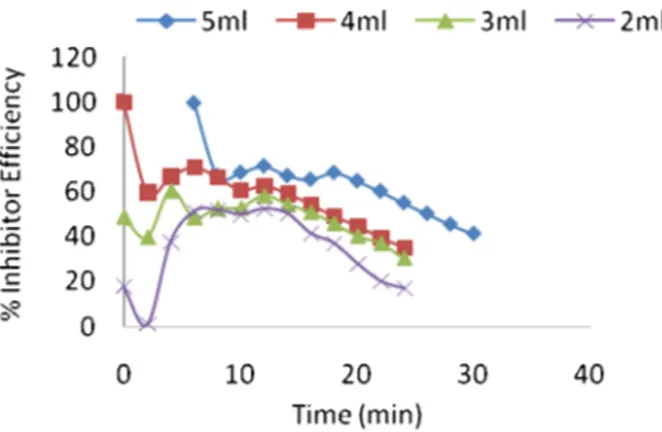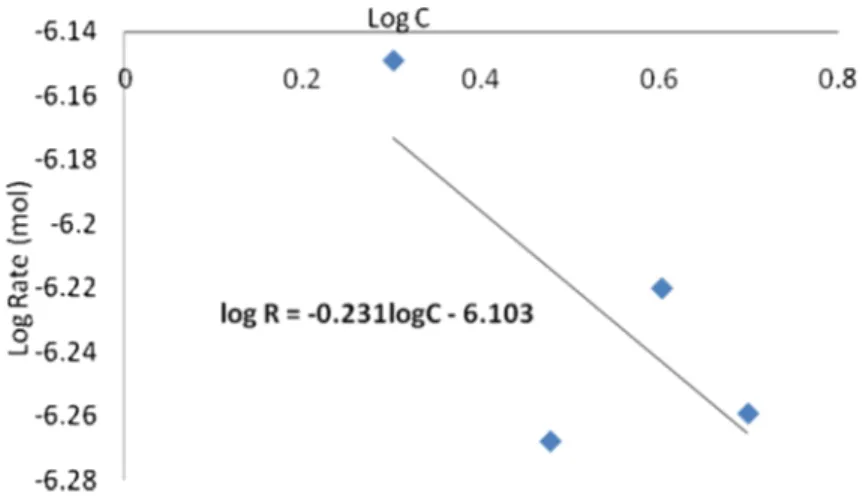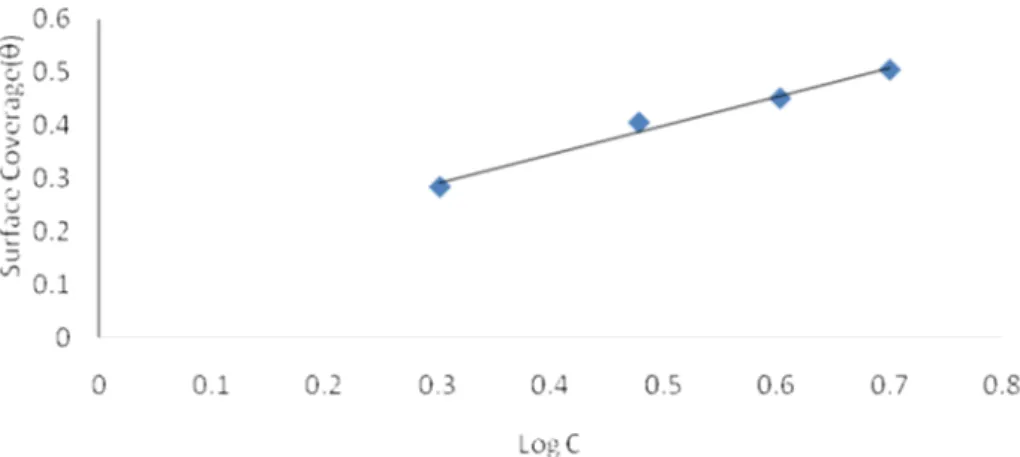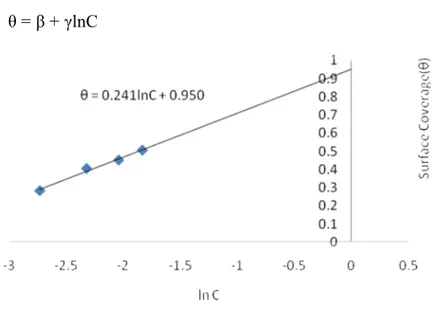Received May 28th, 2011, Revised September 8th, 2011, Accepted for publication October 31st, 2011. Copyright © 2012 Published by LPPM ITB & PII, ISSN: 1978-3051, DOI: 10.5614/itbj.eng.sci.2012.44.1.6
Investigating the Acid Failure of Aluminium Alloy in 2 M
Hydrochloric Acid Using
Vernonia amygdalina
Olugbenga A. Omotosho & Oluseyi O. Ajayi
Mechanical Engineering Department, Covenant University, P.M.B. 1023, Ota, Nigeria
Email: oluseyi.ajayi@covenantuniversity.edu.ng
Abstract. The acid failure of aluminium alloy in 2 M hydrochloric acid solution in the presence of Vernonia amygdalina extract was investigated using gasometric technique. Aluminium alloy coupons of dimension 4 cm by 1 cm were immersed in test solutions of free acid and also those containing extract volumes of 2, 3, 4 and 5 cm3 at ambient temperature for 30 minutes. The volumes of hydrogen gas evolved as a result of the rate of reaction were recorded and analyzed. Analysis revealed that maximum inhibitor efficiency which corresponds to the lowest corrosion rate was obtained at optimum inhibitor volumes of 5 cm3, with reduction in the corrosion rate observed to follow in order of increasing extract volumes. Adsorption study revealed that Temkin isotherm best described the metal surface interaction with the extract phytochemicals, with 12 minutes becoming the best exposure time for the phytochemicals to adsorb to the metal surface at all volumes. Statistical modelling of the corrosion rate yielded an important relationship suitable for estimating corrosion rate values once volumes of the extract is known. Microstructural studies, showed an indirect relationship between crack growth rates and extract volumes, while consistency of the irregular intermetallic phases increases with increasing extract volumes.
Keywords: Acid failure; adsorption; aluminium alloy; green inhibitors; hydrogen evolution.
1
Introduction
Industrial operations of oil well acidizing, cleaning and acid pickling involve the exposure of metals to aggressive agents. In oil well acidizing various volumes of hydrochloric acids are used to dissolve carbonate deposits or scales which interfere with oil passage in the tubing. However, the lines and tubing must be protected during this operation from corrosive attack which induces cracks, by the acid, by high temperatures and pressures, and by the potential for a sour environment resulting from the high hydrogen sulphide and carbon dioxide contents.
Studies [2-6] have shown that several synthetic inhibitors are often used for the purpose of combating damage of metals in service. These inhibitors have been found to be toxic to the environment by harming aquatic and plant life in the ecosystem. Increasing awareness for a clean, sustainable and green environment that is devoid of the use of substances that are environmentally damaging has encouraged the use of inhibitors from plant sources. This group of inhibitors have been found to be cheap, easily accessed and replenished, non toxic and equally effective in action. Numerous studies have been reported on the protective action of green inhibitors on metals in acidic and alkaline solutions [7-14], with a few of them focusing on the Al-alloy [15-17]. Of all the previous studies conducted so far, none yet has worked on investigating the acid failure of Al-alloy in 2 M hydrochloric acid using Vernonia amygdalina leaf extract. Also, in contrast to previous studies that deduced corrosion rate from weight loss measurements, the uniqueness of the approach adopted in this study was to employ the rate of evolution of hydrogen (H2) gas as a measure of the rate at which the alloy is corroding in the presence of Vernonia amygdalina(VA). The basis for using this technique was based on the theory that the rate at which metal is depleted after exposure corresponds to the rate of evolution of H2 gas since it was discovered that increased metal loss resulted in rapid rate of evolution of hydrogen gas.
This will enable the engineers to have a pre-knowledge of the situation and know when to carry out particular type of maintenance. The focus of this study therefore is to establish the relationship between corrosion rate and the rate of evolution of H2gas as well as determine other necessary parameters that relate to metal surface phenomenon in a particular environment. Furthermore, inhibitor efficiency was determined by the method adopted by Okafor et.al [20-23] and the corrosion rate modeled statistically. The investigation further goes on to analyze the adsorption mechanism of the extract and also its effect on the microstructure of the alloy.
2
Materials and Methods
Rectangular specimens of Al metal coupon of dimension 4 x 1 cm were employed for the determination of corrosion inhibition of VA extract. Specimens were prepared by degreasing in ethanol and acetone. It was then allowed to dry. The composition of the Al samples was analyzed using Optical Emission Spectrometer (OES) and the result as obtained is presented in the table below.
Table 1 Composition of aluminium alloy employed.
S/N Element wt %
1. Silicon 0.157
3. Cadmium 0.0005
4. Iron 0.282
5. Calcium 0.0011
6. Copper 0.0025
7. Cobalt <0.0010
8. Manganese 0.024
9. Lithium <0.0002
10. Magnesium 0.51
11. Sodium 0.0005
12. Zinc <0.0010
13. Phosphorous <0.0010
Table 1 (continued)Composition of aluminium alloy employed.
S/N Element wt %
15. Lead <0.0005
16. Chromium 0.023
17. Tin <0.0010
18. Titanium 0.0049
19. Strontium <0.0001
20. Silver <0.0001
21. Vanadium 0.0035
22. Boron 0.0007
23. Zirconium 0.0020
24. Beryllium <0.0001
25. Al 99
26. Bismuth <0.0010
The acidic extracts of VA were prepared from its fresh leaves after it has been air dried and ground into powder. Ten grams (10g) of the powder was then put into a flat bottom flask containing 200 cm3of 2 M HCl solution. The resulting solution was refluxed for 2 hours and left over night before it was filtered. Extract quantity of 2, 3, 4, and 5 cm3obtained by serial dilution were employed for the investigation and the experimental set up is as presented in Figure 1. Each specimen was dropped into the mylius cell containing 50 cm3 of test solution system at room temperature. The volume of H2 gas evolved per 120 seconds interval was recorded for 30 minutes in a calibrated tube by downward displacement of water and the plot of volume against the interval was carried out and represented in Figure 2. The inhibition efficiency was then determined using the technique adopted elsewhere [20-23]:
H HI
HV -V
I.E % =
× 100
V
(1)Figure 1 Schematic diagram of the experimental set up [20-23].
Figure 2 Variation of volume of H2(cm 3
) evolved with time (minutes) of Al coupons for different volumes of VA extract in 2M HCl at room temperature.
material loss when the relationship between the weight loss and H2 gas evolution is known. The basis for this is as represented in Eq. 2 [21-23]:
ΔV α ΔW
dΔV dΔW
α
dt dt
But R α dΔW α dV
dt dt (2)
where,
α
= proportionality signΔV
= volume of H2gas evolvedΔW
= metal weight loss due to corrosionR = rate of corrosion t = time (minutes)
Thus to determine Eq. 2, it is necessary to develop a relationship between volume evolved and the time of evolution. This was arrived at by a polynomial regression analysis of the volume of H2 gas against time leading to Eq. 3 [21-23]:
2
V = c + bt + at (3)
Thus
,
dV
R = = b + 2at
dt (4)
A particular case of this study will involve adapting Eq. 3 and 4 to the
volume-time measurement for individual volume of extract. For instance,
for measurement relating to 5 cm
3extract, the corrosion rate model is
presented as Eq. 6 [21-23]:
2
V = -3.247 + 1.227t + 0.00197t (5)
dV
= 1.227 + 0.0394t
3
Results and Discussion
Examining Figure 2 revealed that the corrosion rate of Al-alloy as indicated by the amount of H2 evolved decreased in the presence of VA when compared to the control. The amount of H2 evolved also decreased with increasing volume of the extract. This indicates that the VA extract in the solution has an inhibitive effect on the corrosion of Al in HCl and that the extent of inhibition depends on the amount of VA extract present. However, 2 cm3 extract became effective after the 12th minute when compared to the control, while the 3 and 4 cm3 extract became effective between the 10th and 12th minute and then the 5 cm3 extract became effective just on the 10th minute of the experiment duration. This same trend was observed in Figure 3 which shows the percentage inhibition efficiency (% I.E).
Figure 3 Percentage inhibition efficiency of varying volumes of VA extracts with time (minutes) on Al coupon in 2M HCl solution at ambient temperature.
Thus, at the beginning of the reaction, % I.E. dipped for all the extract volumes, while % I.E. attained the highest values and became stable between the 8thand 14thminute of the experimental duration, showing that a relationship might exist between this particular times and % I.E. In a way it suggests that a complex formation might have resulted from the reaction between HCl, Al-alloy and the extract phytochemicals. However, for all extract volumes the % I.E. values began to drop after about the same time (16th minute) with 2 and 5 cm3 extract showing the highest and lowest drop respectively.
volumes, though only marginally. The reduction in corrosion rate in the presence of VA extract at different volumess was observed to follow the order; 2 cm3extract < 3 cm3extract < 4 cm3extract < 5 cm3extract.
Figure 4 Corrosion rate of varying volumess of VA extract with time (minutes) on Al coupon in 2M HCl solution at room temperature.
Figure 5 Plot of Log of corrosion rate against log of the acid extract volumes.
LogR = Logk + BLogC (7)
where,
R
= corrosion rate
k
= reaction constant
B
= specific reaction constant and
C
= volumes.
Therefore to obtain reaction constant, the corrosion rates obtained from H2 evolution method must be converted to the same unit (mol min-1) by assuming that H2 evolution reaction occurred at 1.01325×10
-5
Pa. Figure 5 shows the relationship between LogR and LogC for the Al-alloy coupon sample. The straight line in the graph correlates all the points with a correlation coefficient of 0.73. The estimated k and B values were 7.89×10-7 mol min-1 and -0.231. This is divergent to the positive value of B obtained in other studies [24-25] when no inhibitors were used, therefore, the negative value of B indicates a decreasing slope which significantly depicts the inhibitive action of the VA extract on the Al-alloy corrosion. Thus, the exact relationship can be described as:
7 -0.231
R = 7.89 10 C (8)
This perspective is in accord with Figure 4, where a clear cut distinction was observed between the control and inhibited solutions.
3.1
Adsorption Studies
The mechanism of interaction between the phytochemicals in the VA extract and the metal surface can be explained using various adsorption isotherms. The degree of surface coverage, θ, for the different inhibitor volumess were evaluated based on volume of H2gas evolved measurements. Efforts were then
made to fit the θ values using the correlation coefficient with different
adsorption isotherms namely, Langmuir (0.978), Freundlich (0.984), Frumkin (0.329) and Temkin (0.99). However, the Temkin isotherm was found to be best
fitted to the θ values as it showed the highest coefficient of correlation. This
was expected, as the method has been reported to be superior in the prediction
of gas phase equilibra [26]. The plot of θ as a function of logarithm of volumes
of VA is shown in Figure 6.
between phytochemicals and Al-alloy. This phenomenon is an important tribological consideration in metal surface preparation.
Figure 6 Variation of surface coverage (θ) with logarithm of volumes of acid extract showing compliance with Temkin isotherm.
Furthermore, the degree of surface coverage, θ, for the extract at different
volumes was plotted for different time intervals of 8, 12, 16, 20, 24, 28 and 30 minutes as shown in Figure 7 to investigate if there are any contribution of
times of exposure to the relationship between θ and C.
Figure 7 Variation of surface coverage (θ) with extract volumes (M) at different time intervals.
beginning to the end of the experiment. However, for the 12 minutes curve
which is closely followed by the 16 and 20 minutes curve, the θ values were
high throughout the experiment even as extract volumes increased, showing that this is the best exposure time for the phytochemicals in the extract to adsorb to Al-alloy surface. This further validates the assertion in Figure 3 that clearly indicates that the peak I.E (%) value was between the 8thand 14thminutes for all extract volumes employed in the study.
The values of θ were also plotted against lnC and presented in Figure 8. Further
study on the adsorption phenomenon required correlating θ against lnC (i.e
natural logarithm of volumes) as shown in Figure 8, in such a way that [27]:
θ = β + γlnC (9)
Figure 8 Variation of Surface Coverage (θ) with natural logarithm of volumes (M).
where:
β (ml/ml) = RTlna
b (10)
γ = RT
b (11)
a
= Temkin constant related to the maximum adsorption capacity
b
= Temkin constants related to the energy of adsorption.
R and T are the gas constant (8.314 J mol-1 K-1) and temperature (298 K) respectively. From further analysis, the values of the energy of adsorption, b, is estimated to be 10,322.72 J mol-1 while the maximum adsorption capacity, a, in terms of volume of H2evolved is estimated to be 52.36. The estimated value of a, shows that bonding energy exists between the phytochemical and the metal. However, since bonding energy range for ion-exchange is reported [28] to be in the range of 8-16, the value of b indicate that the process cannot be physisorption, as its value is quite high. The values of b, as low as 0.073, is reported elsewhere [28] to depict weak ionic interaction.
The surface effects of the HCl action on the metal in the presence of VA extract were investigated using optical microscope. Also, the photomicrograph studies were performed on these samples in order to evaluate the condition of the Al-alloy surface and grain structure. However, the investigation were carried out on three metal samples which include that of the control experiment (having no inhibitor present), sample from the lowest inhibitor volumes (sample from 2 cm3extract) and sample from the highest extract volumes. These were chosen to study the phenomenon on the case scenario of direct 2 M HCl attack, the least and highest inhibitive effect scenarios, knowing that all others will fall within these limits. Superficial analysis was carried out and the micrograph of the alloy before immersion as observed in Figure 9a, indicate the presence of three
phases,which were the α-Al (white) phase, the Mg5Al8 (grey) phase and the
the higher the extract volumes the slower the crack growth rate and the longer the life of the alloy.
(a) (b)
(c) (d)
Figure 9 Micrographs for Al surface (a) before immersion in 2M HCl solutions (b) after immersion in 2 M HCl for 30 min (c) after immersion in 2 cm3of VA extract for 30 min (d) after immersion in 5 cm3of VA extract for 30 min.
4
Conclusions
corrosion rate yielded an important relationship suitable for estimating corrosion rate once volumes of VA extract is known. The microstructural studies revealed that crack growth rate slowed down and irregular intermetallic phases were more even and undeviating as extract volumes increased, which is in agreement with the initial inference of lowest corrosion rate at optimum extract volumes. Based on the results, the authors recommend the development and calibration of a device that measures corrosion rate based on the principle that metal depletion after exposure is directly proportional to the volume of H2 gas evolved. This may require that a further study be conducted to determine the exact relationship between the volume of H2gas evolved and the corresponding amount of metal depleted.
References
[1] Gunter, S., World Corrosion Organization, www.corrosion.org/ images_index/whitepaper.pdf, (10thJanuary, 2010).
[2] Omotosho, O.A., Okeniyi, J.O. & Ajayi, O.O., Performance Evaluation of Potassium Dichromate and Potassium Chromate Inhibitors on Concrete Steel Rebar Corrosion, J. Fail. Anal. & Preven., 10(5), pp. 408-415, 2010.
[3] Ralston, K.D., Chromate Free Corrosion Inhibitors of Aluminium Alloys: Vanadates and Anionic Exchange Clay Pigments, Ph. D Thesis, Ohio State University, 2008.
[4] Faltermeier, R., AMT: A New Corrosion Inhibitor, B.Sc Report, University College London, 1992.
[5] Iannuzzi, M., Young, T. & Frankel, G.S., Aluminium Alloy Corrosion Inhibition by Vanadates, Journal of The Electrochemical Society, 153(12), pp. 533-541, 2006.
[6] Ralston, K.D., Young, T.L. & Buchheit, R.G., Electrochemical Evaluation of Constituent Intermetallics in Aluminium Alloy 2024-T3 Exposed to Aqueous Vanadate Inhibitors, Journal of the Electrochemical Society, 156(4), pp. 135-146, 2009.
[7] Saratha, R., Priya, S.V. & Thilagavathy, P., Investigation of Citrus Aurantifolia Leaves Extract as Corrosion Inhibitor for Mild Steel in 1 M HCl, E-Journal of Chemistry, 6(3), pp. 785-795, 2009.
[8] Ebenso, E.E. & Ekpe, U.J., Kinetic Study of Corrosion and Corrosion Inhibition of Mild Steel in H2SO4 Using Parica Papaya Leaves Extract, W. Afri. J. Biol. Appl. Chem.,41, pp. 21-27, 1996.
[9] Ebenso, E.E., Ekpe, U.J. & Ibok, U.J., Studies on The Inhibition of Mild Steel Corrosion by Some Plant Extracts in Acidic Medium, Discov. and Innov., 10, pp. 52-59, 1998.
Plant Extracts on Aluminium in Acidic Medium, Trans. of SAEST, 39, pp. 117-123, 2004.
[11] Ekpe, U.J., Ebenso, E.E. & Ibok, U.J., Inhibitory Action of Azadirachta Indica Leaves Extract on the Corrosion of Mild Steel in H2SO4, J.W. Afri. Sci. Assoc., 37, pp. 13-30, 1994.
[12] Oguzie, E. E., Studies on the Inhibitive Effect of Occimum Viridis Extract on the Acid Corrosion of Mild Steel, Material Chemistry and Physics, 99(2/3), pp. 441-446, 2006.
[13] Njoku, P.C., Oguzie, E.E. & Nwaogu, U.C., Inhibitive Effect of Aqueous Extracts of Chromolaena Odorata and Vigna Radiata on the Corrosion of Aluminium in Acidic Medium, Journal of Chemical Society of Nigeria, pp. 89-95, 2006.
[14] Martinez, S. & Tagljar, I. Correlation Between the Molecular Structure and the Corrosion Inhibition Efficiency of Chestnut Tannin in Acidic Solutions, Journal of Molecular structure, THEOCHEM, 640(1-3), pp. 167-174, 2002.
[15] Obot, I. B. & Obi-Egbedi, N. O., Ipomoea Involcrata as An Ecofriendly Inhibitor for Aluminium in Alkaline Medium, Portugaliae Electrochimica Acta, 27(4), pp. 517-524, 2009.
[16] Abiola, O.K., Oforka, N.C., Ebenso, E.E. & Nwinuka, N.M., Ecofriendly Corrosion Inhibitors: the Inhibitive Action of Delonix Regia Extract for the Corrosion of Aluminium in Acidic Media, Anti-Corrosion Methods and Materials, 54(4), pp. 219-224, 2007.
[17] James, A.O. & Akaranta, O., Corrosion Inhibition of Aluminium in 2.0M Hydrochloric Acid Solution by the Acetone Extract of Red Onion Skin, African Journal of Pure and Applied chemistry, 3(12), pp. 262-268, 2009. [18] Bonsi, M.L.K., Osuji, P.O., Tuah, A.K. & Umunna, N.N., Vernonia Amygdalina as A Supplement to Teff Straw (Eragrostis Tef.) Fed to Ethiopian Menz Sheep, Agroforestry Systems, 31(3), pp. 229-241, 1995a. [19] Bonsi, M.L.K., Osuji, P.O.& Tuah, A.K., Effect of Supplementing Teff
Straw with Different Levels of Leucaena or Sesbania Leaves on the Degradabilities of Teff Straw, Sesbania, Leucaena, Tagasaste and Vernonia and on Certain Rumen and Blood Metabolites in Ethiopia Menz Sheep, Animal Feed Science and Technology, 52, pp. 101-129, 1995b. [20] Okafor, P.C., Ebenso, E.E. & Ekpe, U.J., Azadirachta Indica Extracts as
Corrosion Inhibitor for Mild Steel in Acid Medium, Int. J. Electrochem.
Sci., 5, pp. 978-993
,
2010.[21] Ajayi, O.O., Omotosho, O.A., Ajanaku, K.O. & Olawore, B.O.,
[22] Ajayi, O.O., Omotosho, O.A., & Ifepe, V.O.,
Acid Failure of Mild
Steel in 2 M Sulphuric Acid in the Presence of Vernonia
amygdalina
, J. Mater. Environ. Sci., 2(2), pp. 186-195, 2011.[23] Ajayi, O.O., Omotosho, O.A., Ajanaku, K.O. & Olawore, B.O., Failure Evaluation of Aluminium alloy in 2M HCl in the Presence of Cola Acuminata, Environ. Res. J.,5(4), pp. 163-169, 2011.
[24] Noor, E.A. & Al-Moubaraki, A.H., Corrosion Behavior of Mild Steel in Hydrochloric Acid Solutions, Int. J. Electrochem. Sci., 3, pp. 806-818, 2008.
[25] Mathur, P.B. & Vasudevan, T., Reaction Rate Studies for the Corrosion of Metals In Acids-I. Iron in Mineral Acids, Corrosion (NACE), 38(3), pp. 171-178, 1982.
[26] Febrianto, J., Kosasih, A.N., Sunarsob, J., Ju, Y., Indraswati, N. & Ismadji, S., Equilibrium and Kinetic Studies in Adsorption of Heavy Metals Using Biosorbent: A Summary of Recent Studies, Journal of Hazardous Materials, 162, pp. 616–645, 2009.
[27] Pandey, P.K., Sharma, S.K. & Sambi, S.S. Kinetics and Equilibrium Study of Chromium Adsorption on ZeoliteNaX , Int. J. Environ. Sci. Tech., 7(2), pp. 395-404, 2010.

